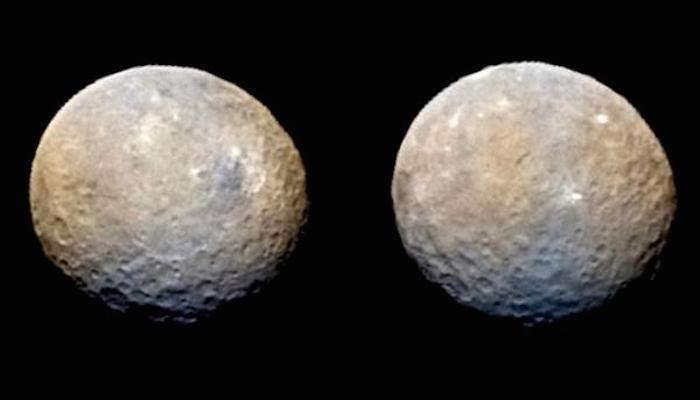.
22.03.2016
Bright Spots and Color Differences Revealed on Ceres
Scientists from NASA's Dawn mission unveiled new images from the spacecraft's lowest orbit at Ceres, including highly-anticipated views of Occator Crater, at the 47th annual Lunar and Planetary Science Conference in The Woodlands, Texas, on Tuesday.
.
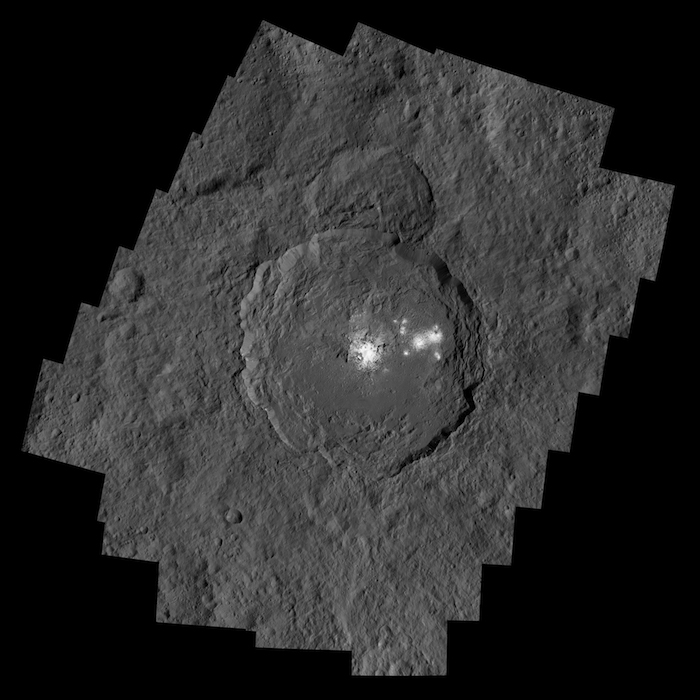
Occator Crater, measuring 57 miles (92 kilometers) across and 2.5 miles (4 kilometers) deep, contains the brightest area on Ceres.
.
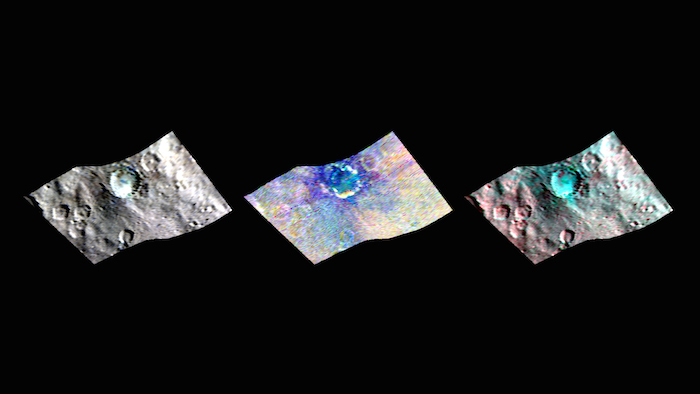
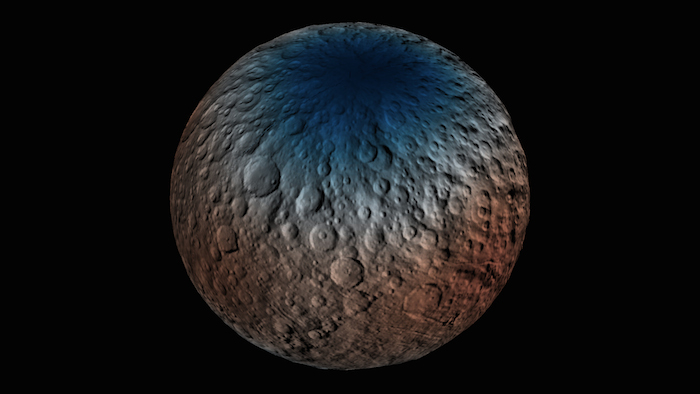
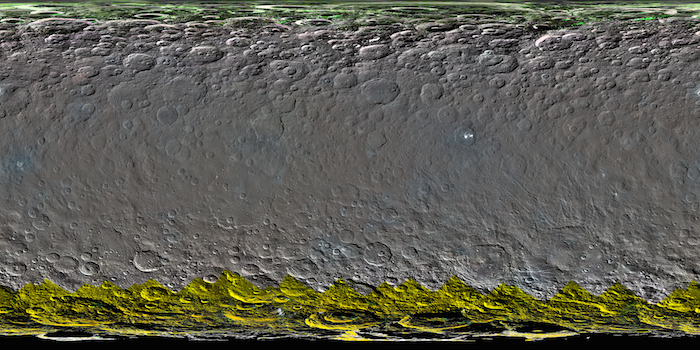
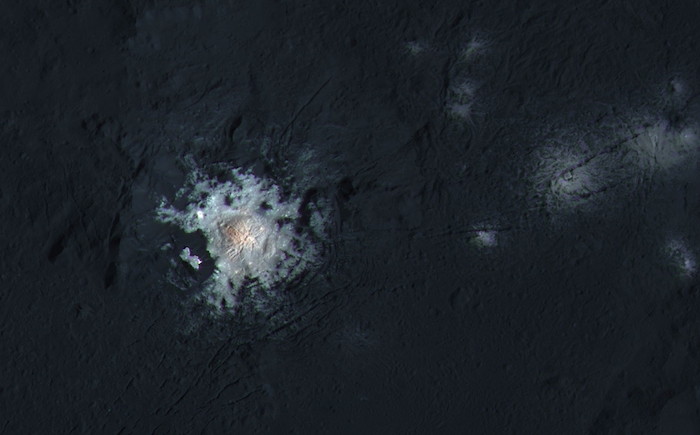
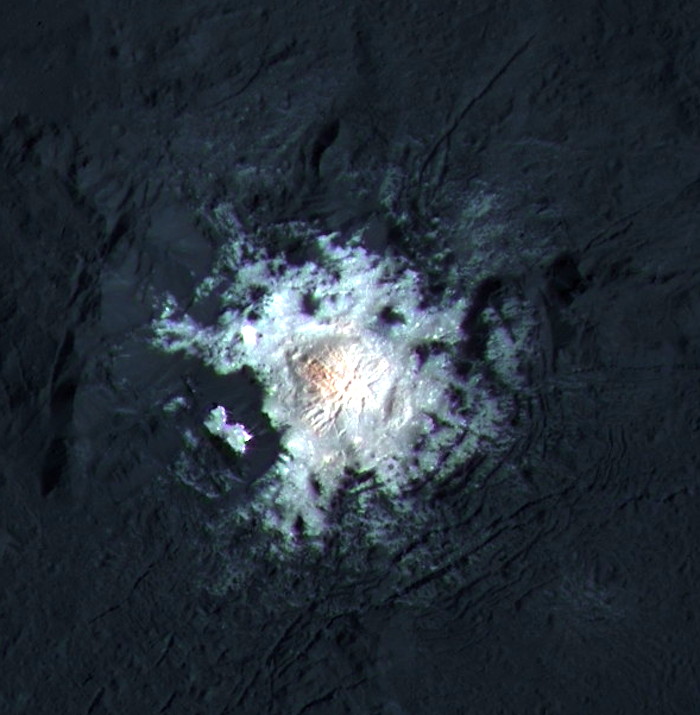
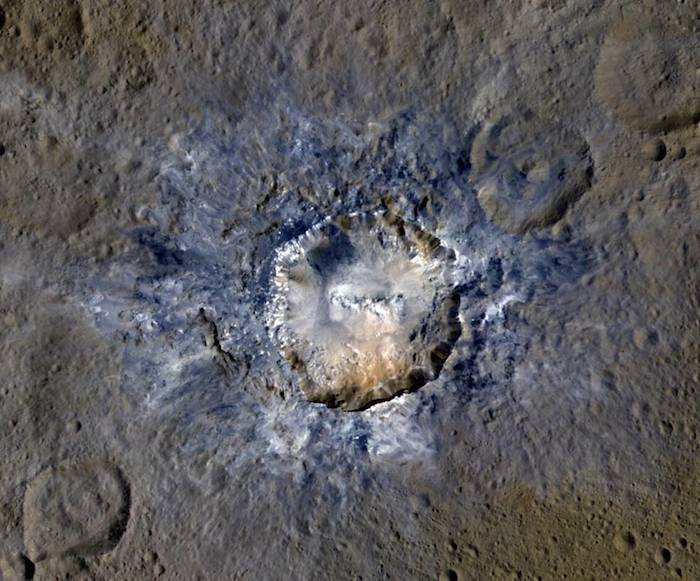
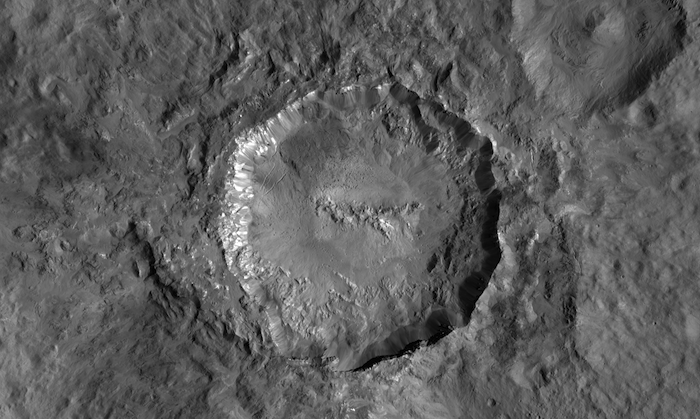
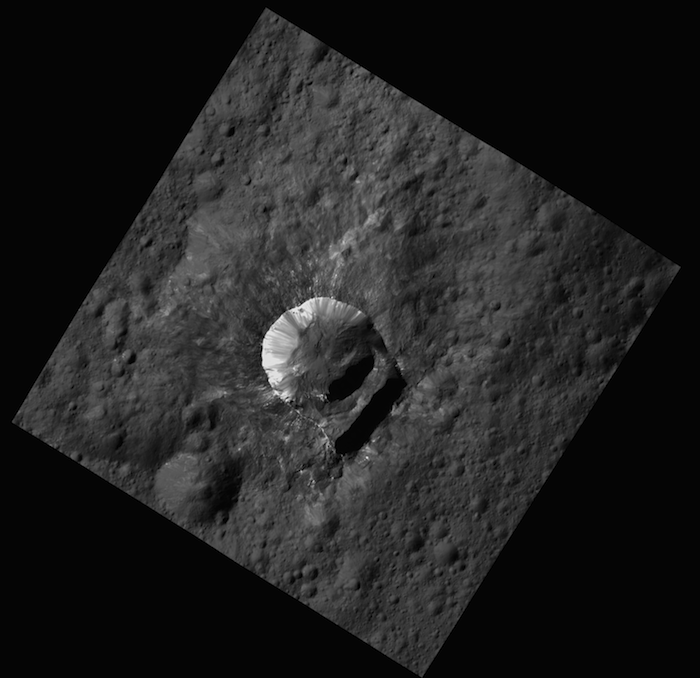
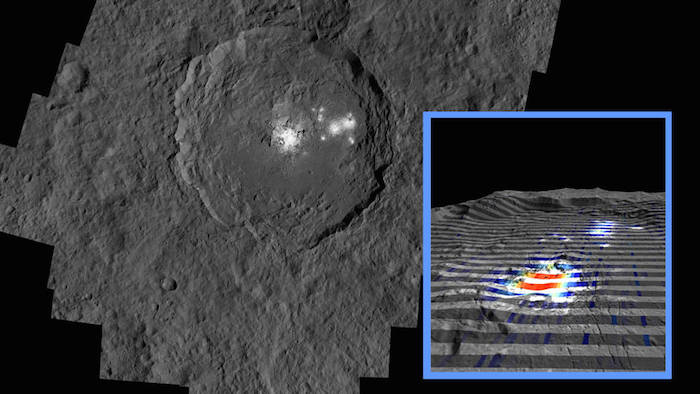

Dawn Completes Primary Mission
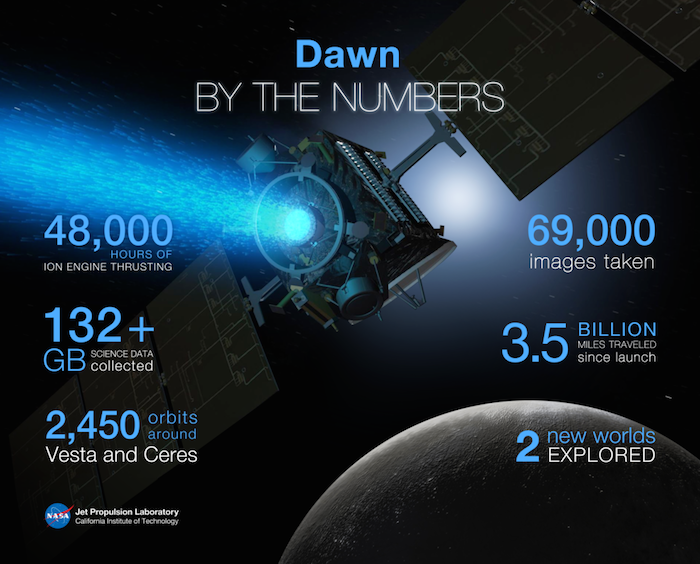
Dawn Maps Ceres Craters Where Ice Can Accumulate

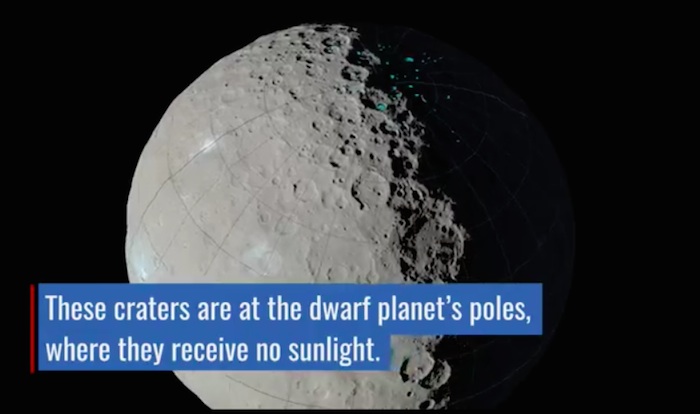
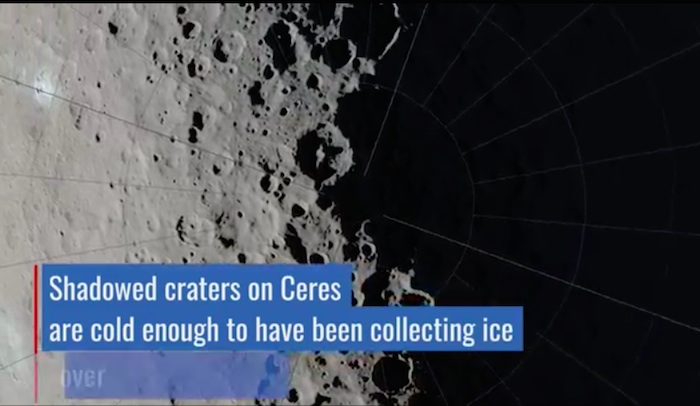
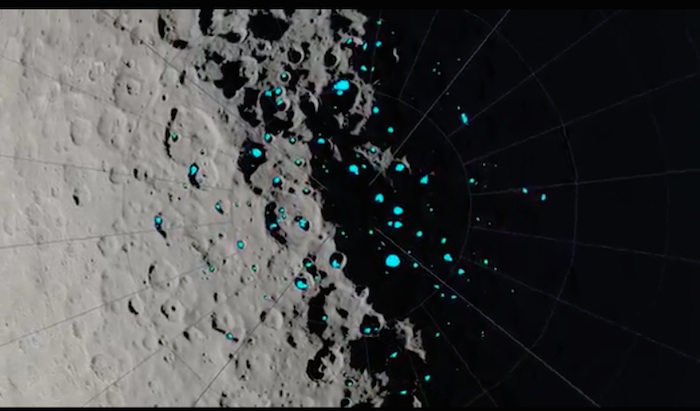
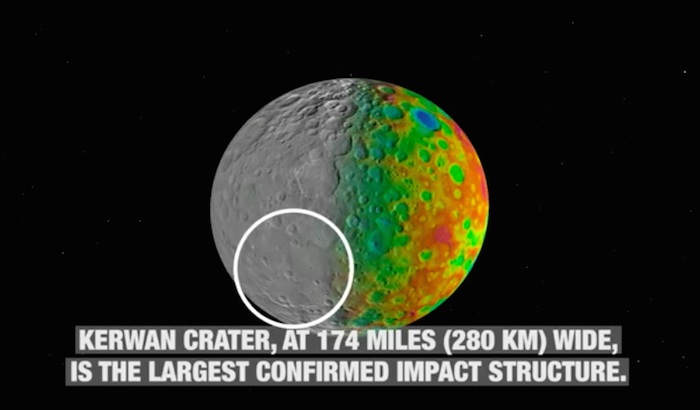
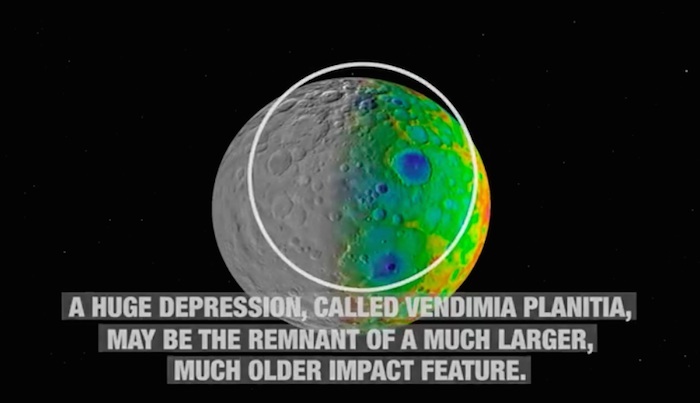
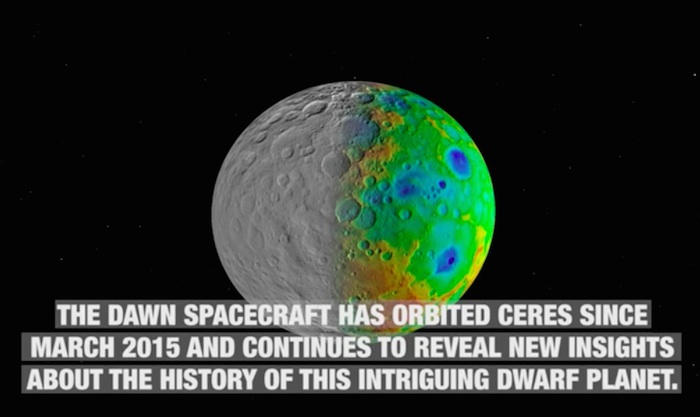
In the tens of thousands of photos returned by NASA’s Dawn spacecraft, the interior of Ceres isn’t visible. But scientists have powerful data to study Ceres’ inner structure: Dawn’s own motion.
Since gravity dominates Dawn's orbit at Ceres, scientists can measure variations in Ceres’ gravity by tracking subtle changes in the motion of the spacecraft. Using data from Dawn, scientists have mapped the variations in Ceres' gravity for the first time in a new study in the journal Nature, which provides clues to the dwarf planet's internal structure.
"The new data suggest that Ceres has a weak interior, and that water and other light materials partially separated from rock during a heating phase early in its history," said Ryan Park, the study’s lead author and the supervisor of the solar system dynamics group at NASA’s Jet Propulsion Laboratory, Pasadena, California.
Ceres' gravity field is measured by monitoring radio signals sent to Dawn, and then received back on Earth, by NASA’s Deep Space Network. This network is a collection of large antennas at three locations around the globe that communicate with interplanetary spacecraft. Using these signals, scientists can measure the spacecraft's speed to a precision of 0.004 inches (0.1 millimeters) per second, and then calculate the details of the gravity field.
Ceres has a special property called "hydrostatic equilibrium," which was confirmed in this study. This means that Ceres' interior is weak enough that its shape is governed by how it rotates. Scientists reached this conclusion by comparing Ceres' gravity field to its shape. Ceres' hydrostatic equilibrium is one reason why astronomers classified the body as a dwarf planet in 2006.
The data indicate that Ceres is “differentiated,” which means that it has compositionally distinct layers at different depths, with the densest layer at the core. Scientists also have found that, as they suspected, Ceres is much less dense than Earth, the moon, giant asteroid Vesta (Dawn’s previous target) and other rocky bodies in our solar system. Additionally, Ceres has long been suspected to contain low-density materials such as water ice, which the study shows separated from the rocky material and rose to the outer layer along with other light materials.
"We have found that the divisions between different layers are less pronounced inside Ceres than the moon and other planets in our solar system," Park said. “Earth, with its metallic core, semi-fluid mantle and outer crust, has a more clearly defined structure than Ceres," Park said.
Scientists also found that high-elevation areas on Ceres displace mass in the interior. This is analogous to how a boat floats on water: the amount of displaced water depends on the mass of the boat. Similarly, scientists conclude that Ceres’ weak mantle can be pushed aside by the mass of mountains and other high topography in the outermost layer as though the high-elevation areas "float" on the material below. This phenomenon has been observed on other planets, including Earth, but this study is the first to confirm it at Ceres.
The internal density structure, based on the new gravity data, teaches scientists about what internal processes could have occurred during the early history of Ceres. By combining this new information with previous data from Dawn about Ceres' surface composition, they can reconstruct that history: Water must have been mobile in the ancient subsurface, but the interior did not heat up to the temperatures at which silicates melt and a metallic core forms.
"We know from previous Dawn studies that there must have been interactions between water and rock inside Ceres," said Carol Raymond, a co-author and Dawn’s deputy principal investigator based at JPL. "That, combined with the new density structure, tells us that Ceres experienced a complex thermal history."
Quelle: NASA
-
Update: 2.09.2016
.
Dawn probe paints picture of icy, rocky Ceres – with an ice volcano
NASA scientists take stock of the treasure trove of data on the largest object in the asteroid belt. Angus Bezzina reports.

NASA’s Dawn spacecraft has beamed back an abundance of information about dwarf planet Ceres, painting a new picture of the gigantic, pockmarked asteroid made of ice and rock – and sporting an ice volcano.
The papers were published in Science today.
Discovered in 1801, Ceres is the largest object in the asteroid belt that whirls around the sun between Mars and Jupiter. It is thought to be a protoplanet – a mass that was on its way to becoming a planet before the gravitational pull of Jupiter stopped it from accumulating enough mass – and one of the oldest pieces of the solar system, forming within the celestial array’s first five to 15 million years.
Planetary scientists think Ceres contains a layer of water-ice below its dusty outer crust – similar to Jupiter’s moon Europa and Saturn’s moon Enceladus, which are both considered to be potential sources for harbouring life.
Information about the dwarf planet has come from a combination of sources including microwave studies, and analyses of meteorites thought to have originated from another, similar dwarf planet, Vesta.
But the lion’s share comes from the Dawn spacecraft, launched by NASA in 2007 to get a better understanding of Ceres, Vesta and the origins of the solar system.
Now, a deluge of recent Dawn data has been presented in six papers.
Surface watermarks
While we’ve known for a while that the dwarf planet contains water – we’ve seen water vapour emissions from the surface – exactly what the nature of the water was has been vague.
Theories have long suggested Ceres has a mantle rich in ice – and they’re right.
Jean-Philippe Combe from the Bear Fight Institute in the US and his colleagues describe ice on the surface of the dwarf planet.
The Dawn spacecraft found the mass of ice as it scanned the 10-kilometre-wide, geologically fresh Oxo crater with is visible light and infrared mapping spectrometer.
More water-based revelations on Ceres from the spectrometer were provided by Eleonora Ammannito from the National Institute of Astrophysics in Italy and her colleagues. But rather than water ice, they uncovered a number of phyllosilicate (hydrated, rock-forming) minerals in Ceres’ clay-like crust.
They found magnesium and ammonium bearing minerals all over Ceres’ surface but their abundance varied considerably from place to place.

Ice volcanoes
Ceres’ distinctive outer shell is the product of a combination of ice and rock and shaped by external impacts, cryomagmatism and cryovolcanism. And it looks as though it has the solar system’s first confirmed ice volcano.
Ahuna Mons is largest mountain on Ceres – but Ottaviano Ruesch from NASA’s Goddard Space Flight Centre in the US and his colleagues believe it is an ice volcano (also called a cryovolcano).

Their claim is based on extensive modelling of the formation’s topographic profile.
If correct, it would mark the first evidence of a cryovolcano, although scientists have predicted their existence before as they observed molten ices.
Ruesch and his colleagues claim that features such as Ahuna Mons’ elliptical base and concave top are especially indicative of cryovolcanism because it consists of a brittle outer shell with pressurised, fluid-like material inside.

Meanwhile, Debra Buczkowski from Johns Hopkins University in the US and her colleagues conducted a broader analysis of Ceres’ topography and geomorphology. Their report was based on a geomorphic analysis and physical modelling of the images collected by Dawn’s framing camera.
Buczkowski and her team discovered that while Ceres is covered with a large number of craters, features such as grooves, pit crater chains and troughs are also scattered around.
They argue that many of these features indicate near-surface cryovolcanism.
They also claim that although only one instance of surface ice on Ceres has been detected so far, the presence of these other potentially ice-related features suggests that there is ice in other parts of Ceres’ crust.
Harald Hiesinger from the University of Münster in Germany and his team found something similar when they looked at more images taken by the same camera on the Dawn spacecraft.
According to them, the thermochemical models that had been developed by scientists in the past predicted Ceres should have an icy crust with few or no impact craters.

And although Hiesinger and his colleagues’ observations revealed no large craters, the pictures contradicted predictions, as they showed a varied and heavily cratered surface.
Some impact craters seemed “relaxed” in shape – evidence the ground there was icy – while others were not – indicating something harder such as rock.
They suggest that this, along with the varied features of the dwarf planet’s surface such as polygon-shaped craters, smooth deposits and bright spots suggest that Ceres’ surface is a combination of ice and rock, not one or the other.

Up in the sky
Christopher Russell from the University of California, Los Angeles in the US and his colleagues looked off the little world to its atmosphere.
They peered through the eyes of Dawn’s gamma-ray and neuron detector instrument and mapped charged particles from the sun curving around the dwarf planet. How did this happen?
The most likely explanation was that Ceres’ weak atmosphere was ionised – that is, molecules had electrons stripped away – by particles streaming from the sun. This solar wind was deflected around the dwarf planet.
Their other explanation was that the salty interior generated an electric current, which created a magnetic field which deflected solar particles – in the same way Earth’s magnetic field does.
And this isn’t the last we’ll hear of Dawn. The mission is still active – just today it was moved into a slightly higher orbit to see things from a slightly different angle – and is expected to send back information about the mysterious dwarf planet until 2017 at least.
Quelle: COSMOS
-
Update: 4.09.2016
.
Ice Not a Major Factor of Dwarf Planet Ceres’ Surface Features
---
Sulfur, Sulfur Dioxide and Graphitized Carbon Observed on Asteroid For First Time
